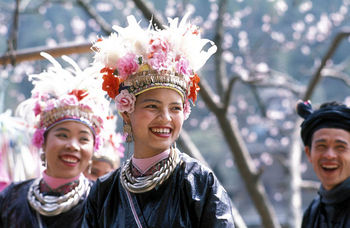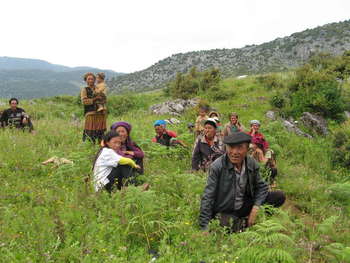Coming of Age Ceremonies in China
Traditionally Chinese men became adults at the age of 20 during the capping ceremony. Women became adults at the age of 15 during the hairpin ceremony. Both ceremonies were traditional in Ancient China. It is believed that these ceremonies are more than 2000 years old. There are evidences that they were held in the period of Zhou Dynasty (1045 BC–256 BC).
The ceremony for men was called capping because hair of 20 years old one was turned to a bun or coil and the person then wore a special cap. The ceremony was held in February. Three days before the ceremony the man chose an honoured guest whose duty was to perform the ceremony. A capping assistant was also chosen to help the honoured guest.
During the ceremony the host (usually the father of person who reached 20), honoured guest and the person who is going to be capped wore special clothes. The man first got his inner cap, then a cap and finally a scarf. After this three steps the man's hair was combed into a bun. Symbolically this meant that he became an adult.
The guest of honour then gave a speech congratulating the new adult man. After the speech the new adult man would take a bow to his mother. Then the guest of honour would give him a new name.
The women of 15 had a hairpin or hair-pinning ceremony. Her hair was gathered into a knot. A hair pin was used to keep it together. The ceremony was held between woman's engagement and her wedding. Sometimes the ceremony was organized when the woman reached 20 but not later.
The procedure of the hairpin ceremony was almost the same as the capping one. Still, there were several differences. Most of those participating in the ceremony were women. The woman would also get a cornet. The whole ceremony was held inside the house – in a main room or in an inner chamber.
China recognizes 56 ethnic minorities. All of them have numerous traditions concerning coming of age.
The Pumi or Primi people live in the Yunnan region located in the far southwest of China. Their children become adults when they are 13 years old. Pumi people hold a ceremony in which person first steps on a piece of fat with his/her right foot and then steps on a bag of rice with the left foot.
What follows is “kowtow” to the cooking stove, oldest members in the family and elder brothers. Kowtow is a traditional way of kneeling and bowing. Person performing it bows very low and with his/her head touches the ground. As result of becoming an adult person can dress the way adults do and participate in many social activities.
The Blang or Bulong people also live in the Yunnan region. Smaller communities of the Blang exist in Myanmar and Thailand. Their coming of age ceremony is called “baoji”. During baoji people sit around fire. Every person dyes teeth of the one sitting next to him or her in black. People participating in baoji get presents from adults.
We are still in the Yunnan region. Jino or Jinuo people belong to a Tibeto-Burman ethnic group. Their coming of age ceremony differs between boys and girls. For girls the ceremony is held when they turn 15. From that day on they are allowed to change their aprons, wear different hair-styles and carry bag called “tongpa” on their back.
Jino boys become adults in ceremony held when they turn 16. After the ceremony they can wear head wrapper called “baoutou” instead of a hat. Also the same as girls they are allowed to carry tongpa sent by parents. After the ceremony both boys and girls become formal members of the community.
 Dong people
Dong people
The Dong people, or as they call themselves Gaemi people, live in Guizhou, Hunan, and Guangxi provinces. Dong community also exists in Vietnam. Dong people actually have three coming of age ceremonies which are held when boys turn 5, 10 and 15. During these ceremonies boys roll in the mud.
At the age of 5 and 10 parents help boys to perform the ceremony. But when they are 15 they perform it themselves.
 Yi people
Yi people
The Yi or Nuosu people live in Yunnan, Sichuan, Guizhou, Guangxi region. Outside China they live in Vietnam and Thailand. The Yi girls aged between 15 and 17 perform a ceremony during which they take off their skirts and start wearing adult skirt. This symbolizes their coming of age.